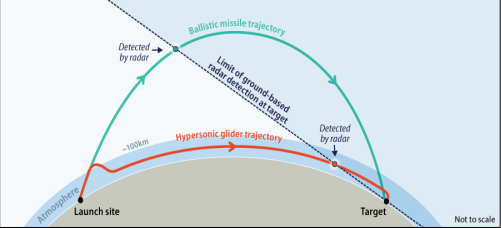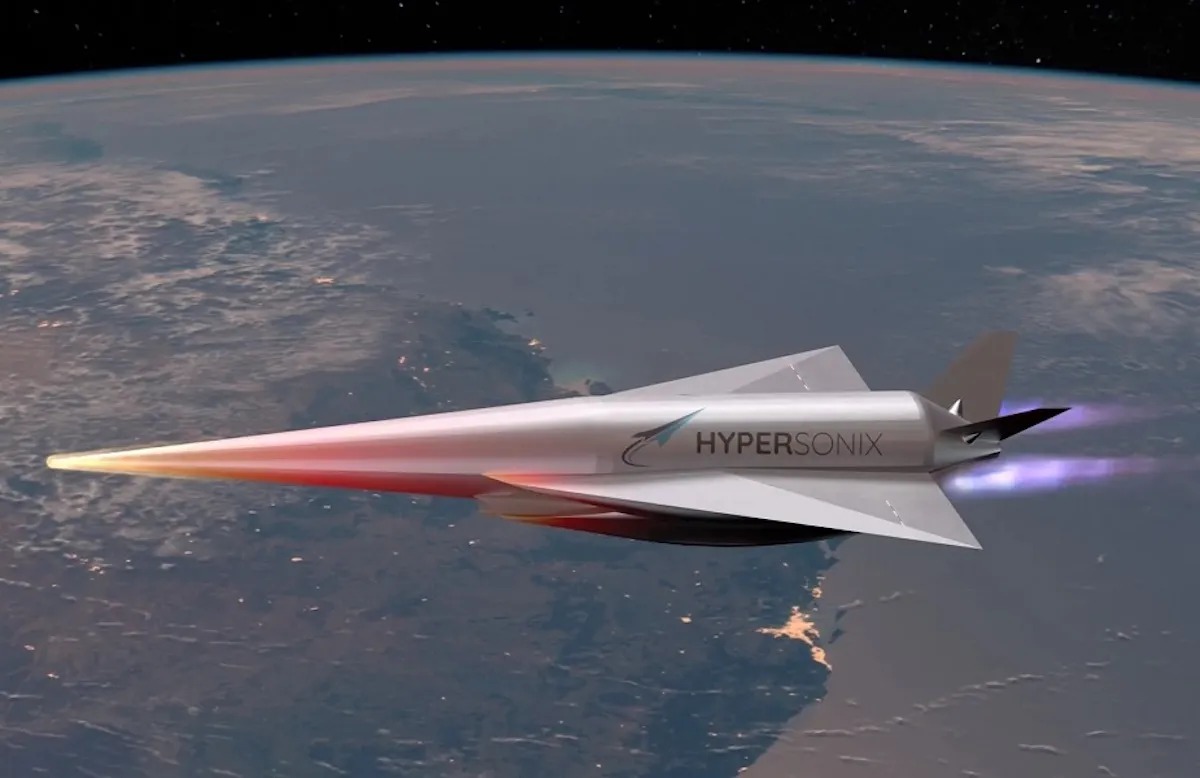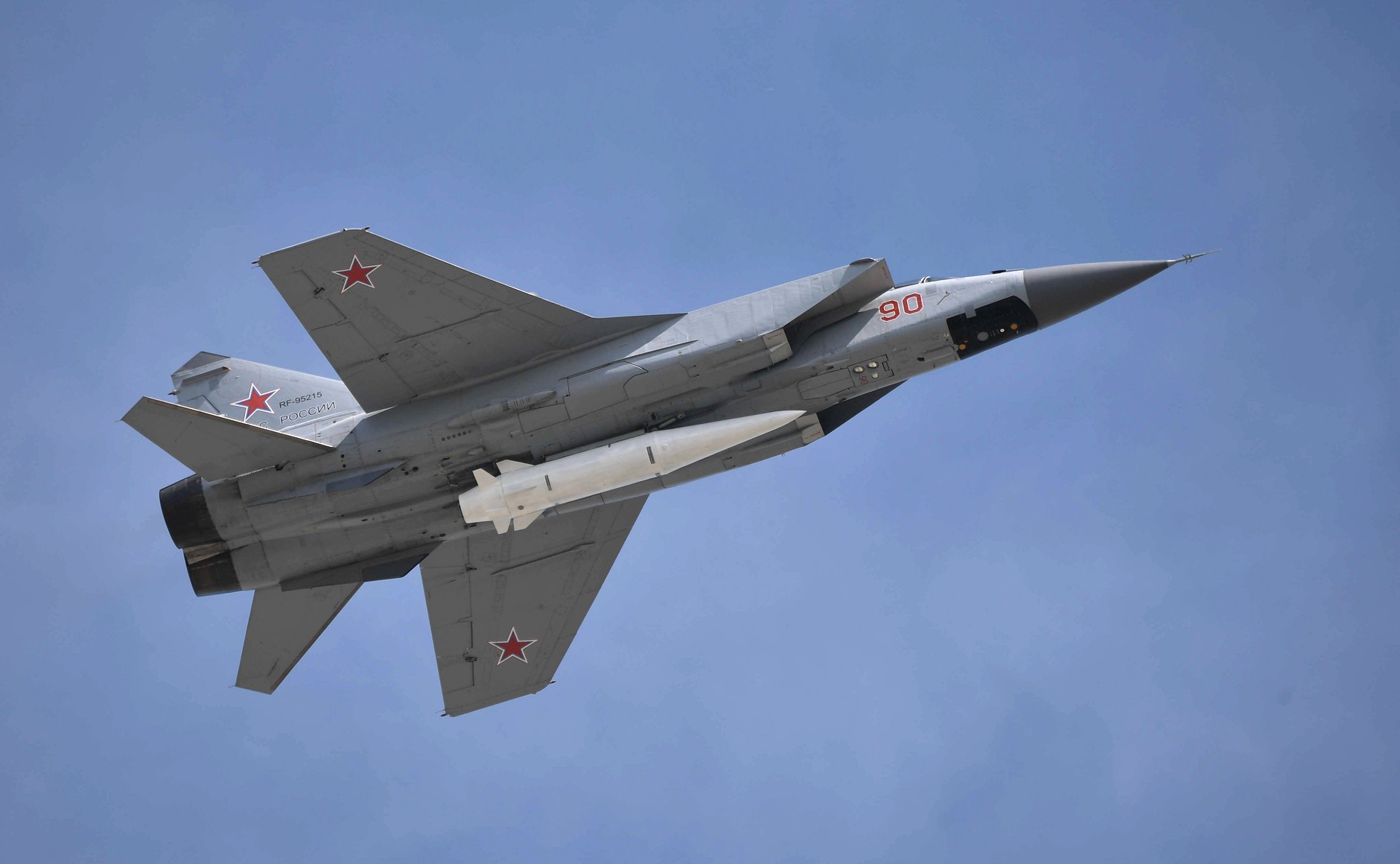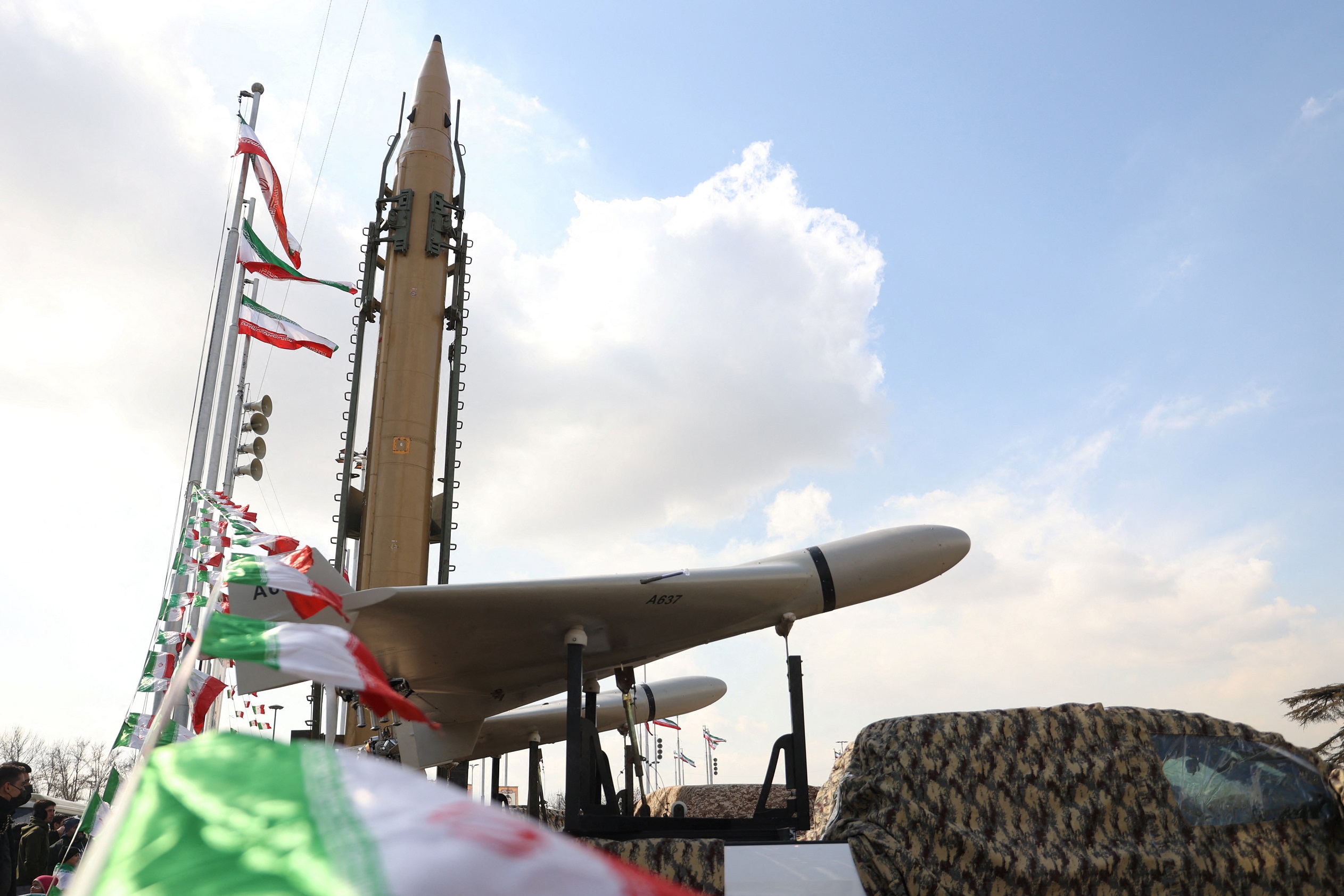Yehoshua Kalisky
The importance of hypersonic missiles has led the superpowers to invest considerable sums in order to achieve a strategic advantage. The article surveys different types of maneuvering hypersonic missiles, the geostrategic significance of these missiles in the battlefield, and possible means of defense by Israel against them
The operational use of maneuvering hypersonic missiles by Russia in the war in Ukraine has demonstrated the threat inherent in such weapons. Maneuvering hypersonic missiles travel on an aerodynamic trajectory at a speed that is 5-10 times the speed of sound (Mach 5-10), and have excellent navigation and maneuvering capabilities that make it difficult to detect and track their trajectory, and consequently to intercept them. Such missiles can carry both conventional and nuclear warheads, and have the ability to strike moving targets precisely, such as aircraft carriers. This article surveys the various kinds of maneuvering hypersonic missiles and the leading countries developing them. In addition, it discusses the geostrategic implications of hypersonic missiles on the battlefield and possible ways of defending against them.
What is a maneuvering hypersonic missile, and why the deep concern about its potential use? This is a missile equipped with a powerful engine that can reach speeds of 5-6 times the speed of sound. There is speculation that the Russians have overcome the problems inherent in alleviating the heat from the missile's shell while in flight, the endurance of the engine's components to high temperatures and pressures, and control and navigation problems, and have succeeded in developing a hypersonic missile that travels at a speed of Mach 10. In addition to speed, a hypersonic missile has a long range and cruise and control capabilities (controlled flight): unlike a ballistic missile, whose ability to maneuver to a target is limited as it travels on a predetermined ballistic trajectory, a hypersonic missile can maneuver in flight and can navigate precisely until hitting its target. This is in contrast with various kinds of ballistic missiles that reach hypersonic speeds when traveling toward the target on a ballistic trajectory but lack maneuverability. Moreover, a hypersonic missile can carry a nuclear warhead.
Types of Maneuvering Hypersonic Missiles
There are two types of maneuvering hypersonic missiles:
Hypersonic glide vehicle (HGV), also known as tactical boost glide (TBG): a hypersonic missile that is launched from a strategic or tactical ballistic missile. The hypersonic missile receives its speed from the ballistic missile or the aircraft that is carrying it; it exits the atmosphere at a height of 80,000 feet, gains great speed – in the range of Mach 20-25 – and afterwards glides long distances, while navigating precisely and maneuvering to the target, lowering speed while gliding but still in the range of hypersonic speeds, that is, above Mach 5. Its navigation and maneuvering capabilities while gliding make the hypersonic glide vehicle a weapon system that is difficult to detect and intercept. Because of its great speed, the amount of time available for the interceptor is very short (Figure 1).
Hypersonic cruise missile (HCM): This is a sophisticated missile that combines the acceleration capabilities of a ballistic missile with the maneuverability of a cruise missile and is equipped with a powerful engine. This missile is launched from an aircraft. For example, according to reports, the American hypersonic missile AGM-183-ARRW, which is carried by a B-52 bomber, can reach a speed of 6,200 km/h. A hypersonic cruise missile is an air-breathing type of missile (Hypersonic Air-breathing Weapon Concept – HAWC).

The engine of a hypersonic cruise missile is a ram-jet engine, or a scramjet engine, which takes in air at high pressure and supersonic speed in order to provide oxygen from an external source by taking air into the engine and burning it with the fuel (Zheng, 2007). This is a self-powered oxygen supply, where the compression of the fuel and the air is done by the movement of the missile and not by a turbine, as is the case in a jet engine. Because this kind of missile does not carry the oxidizer it needs for creating driving force and lacks turbines for compression, it is limited in its flight altitude – to about 60,000 feet – and in its range of operation. An air-breathing missile, which is propelled by a scramjet engine, must be accelerated to a high speed by another platform such as a B-52 aircraft or a missile. On the other hand, due to weight savings and the lack of moving parts, it has reliability, simplicity of production, and the ability to develop high speeds – above Mach 5 – for a short time, which increases its effectiveness.
Leading countries
Due to the importance of hypersonic missiles, the superpowers (which are also technological leaders) invest considerable sums in the development and refinement of hypersonic systems and in the development of means of defense against them.
United States
The United States began to develop hypersonic missiles as part of a plan to develop attack scenarios as early as the year 2000, but these plans were delayed by Congress for various reasons in 2013 and 2014. The research program on developing hypersonic missiles and developing means of defense against such weapons (the Glide Breaker system) was accelerated because of Russia and China's quick progress in this area (Sayler, 2019). For example, in June 2019, the AGM-183A ARRW hypersonic glide missile was revealed. It was documented under the wing of a B-52 bomber, and according to some estimates its speed is 6,200 km/h. This missile was already supposed to be operational, but there are still technical problems with its operation.
Cliff Drubin from the Jane institute (2019) estimates that the United States invested $3.3 billion in 2019 and another $2.6 billion in 2020 in research and development of hypersonic technologies. The planned budget for 2020-2025 for developing hypersonic weapons was doubled from $6 billion to $11.2 billion. The American effort is led by DARPA, the army, and the air force. The objective is to create a conglomerate of industries that will take part in an effort to produce thousands of hypersonic missiles for long-range depth strike targets – low range hypersonic weapons (LRHW), and tactical and strategic targets. As part of the program,
various kinds of air-breathing hypersonic missiles are currently being developed, as well as a tactical boost glide missile (TBG), which can be launched from a ballistic missile. The United States is also developing long-range precision hypersonic missiles, and hypersonic air-breathing cruise missile systems that are launched from air platforms, such as from the F-15EX advanced fighter aircraft or ground-based platforms, in order to upgrade the firepower on the future battlefield (Tadjdeh, 2019(. Another interesting development is a ground-based hypersonic tactical missile called Operational Fires. The Navy has also joined the race to develop hypersonic missiles, allocating $2.5 billion to Lockheed Martin for this purpose, as well as for developing special test sites for examining the performance of hypersonic missiles, as tracking and gathering flight data from an object traveling at hypersonic speeds is a considerable technological challenge. Finally, the US Department of Defense, in cooperation with the Hypersonix company in Australia, is working on the development of a prototype (Figure 2) of an advanced model of a "breathing" missile with a unique ramjet engine with a speed of Mach 7 (around 8,400 km/h), whereas the engine is produced using 3D printing – which saves a lot of production time, leading to cost savings (Honrada, 2023(. The production is based on using special metals and sophisticated coatings to overcome the high temperatures produced in the engine and on the missile's surfaces, which is essential for controlling its trajectory.

Russia
The Russians preceded the United States in developing and incorporating hypersonic missiles in their operational systems. The estimate was that this kind of advanced hypersonic missile would enter service around 2025 at the earliest. These forecasts proved false, as it became clear that Russia and China preceded the United States in developing hypersonic missiles, and perhaps also gained a certain strategic advantage. The performance of a hypersonic missile was demonstrated during the past year in the war against Ukraine. Presumably the Russians wanted to demonstrate the performance and the great advantage of hypersonic weapons compared to regular cruise missiles, and perhaps also to send a threatening message on the strategic level to the United States.
In addition, at the same time, the Russians revealed a video in which a MiG-31 fighter aircraft is seen launching a Kinzhal missile during a training exercise (Figure 3). President Vladimir Putin himself referred to the video and claimed that the Kinzhal missile flies at 10 times the speed of sound, about 12,000 km/h, for a range above 1,250 km (according to Russian sources, the range is about 2,000 km but this is not confirmed by US intelligence sources) with the ability to carry conventional and nuclear warheads. The missile appears operational, at least according to the video, but experts dismissed the figure of Mach 10 and even lower. Because of the great speed and excellent maneuverability of the Kinzhal missile (in contrast with a ballistic missile, whose trajectory can be predicted), there is great difficulty in detecting and continuously tracking its flight, and as a result in the possibilities for intercepting it.

In the first few months following Russia's invasion of Ukraine, a senior commander in Russia's long-range aviation command reported on the operational use of Kinzhal missiles for destroying select ground targets in Ukraine, without any missile having been intercepted by the Ukrainian air defense. These were sporadic strikes, with the intention of demonstrating capabilities. But on March 9, 2023, the Russians carried out a massive attack on cities and critical infrastructure in Ukraine, which included 81 cruise missiles, six of them Kinzhal missiles, causing great destruction. The purpose of the attack is not clear, and analysts attribute it to the Russian desire to achieve victory by destruction and intimidation. Others see this attack as a message and a direct warning to the West on the advanced capabilities that the Russians possess. There were also past reports in Russia on the development of a hypersonic missile called the 3M22 Zircon. According to Russian reports, this missile is designed to destroy ships, and reaches a speed of Mach 8 and a range of 400 km. This missile can be launched from a TU-22 bomber or from a missile ship, as was done in a test conducted in April 2019. Another hypersonic missile is the Avangard – a glide vehicle launched from a ballistic missile, which became operational in 2018 and struck a target at a distance of about 6,000 km.
China
China began an intensive race to develop hypersonic weapons at the beginning of the 21st century, with operational capabilities achieved as early as 2014. In fact, it is estimated that three times as many designated facilities for developing such weapons have been built in China as in Russia. The Chinese see great strategic importance in developing various hypersonic technologies, and as a result they carry out extensive research and development, alongside the development of glide missiles or HAWC missiles, with the intention of threatening the US bases and the US Navy's ships and aircraft carriers in the Pacific Ocean (eurasiantimes.com, May 2023).
A medium-range Chinese hypersonic glide vehicle that is launched from a mobile or stationary launcher up to a distance of 1,800-2,000 km and perhaps more is the Dong Feng 17 missile, known by its abbreviation, DF-17, which travels at an estimated speed in the range of Mach 8-12. The DF-17 missile has a special cross-sectional shape that enables optimal aerodynamic performance and maneuverability at a wide range of speeds, up to Mach 12 and even beyond (Chen, 2020). China also revealed the DF-ZF missile, which has performed at least seven test flights since 2014, most of which have been defined as successful. This is a glide vehicle with the ability to carry a nuclear warhead and is launched from a ballistic missile. It travels at a speed of between 6,000 and 12,000 km/h and reaches a range of about 3,000 km. For example, the Chinese missile DF-41 is an intercontinental ballistic missile with the ability to carry hypersonic glide vehicles that carry nuclear warheads to a range of 14,000 km. Another Chinese hypersonic missile with the ability to carry nuclear weapons at a speed of Mach 6 and is in development is the Starry Sky-2, which is planned to be operational in 2025. In July 2021, the Chinese demonstrated exceptional capabilities that amazed analysts in the United States, when they launched a hypersonic missile on a circular trajectory around the earth.
According to the existing assessments, the Chinese missile is very precise and has the ability to carry a conventional or nuclear warhead. According to some experts, this missile is also designed to destroy US aircraft carriers. China, apparently, is less advanced than the United States in the field, and its research and development budget is smaller than that of the United States, but it is taking giant steps toward closing the gap.
Implications
According to various assessments (Udoshi, 2019, for example), hypersonic weapons are a disruptive technology vis-à-vis all missile and missile-defense technology that exists today, and in effect blurs the line between nuclear weapons and conventional weapons. There are proposals to prohibit tests of hypersonic missiles or establish monitoring mechanisms, supervision, and international non-proliferation treaties for this type of weapon, similar to the START treaty on reducing the strategic weapons in the hands of the United States and Russia, and instituting strict supervision and monitoring measures on the export of technologies or components and knowledge related directly or indirectly to hypersonic missiles (Richard, 2017, pp.109-115).
Hypersonic missiles in the hands of rogue states change the prevailing conception regarding global stability, and constitute a negative factor with respect to stability in sensitive regions and an incentive for an uncontrolled arms race. The combination of a hypersonic missile's ability to strike any target on the earth within an hour and its ability to carry a nuclear warhead poses the potential danger of a strategic war or the escalation of an existing conflict, to the point of a preemptive strike due to uncertainty or mistaken interpretation of the kind of warhead that the missile carries. The implication is that hypersonic missiles increase the danger of war on a global scale.
Russia’s progress in the field and the military alliance between Russia and Iran increase the likelihood that Iran will acquire hypersonic missiles – with grave implications for Israel. As early as 2014 Iran began efforts to research and develop hypersonic technologies via research institutes connected to the Revolutionary Guard and the army, along with leading universities (Richard, 2017, pp. 76-77). A senior officer in the Revolutionary Guard announced on February 25, 2023 that Iran is developing hypersonic missiles with a speed of Mach 8 and higher that maneuver to long distances with the ability to precisely strike stationary and moving targets, such as striking US aircraft carriers at a range of 1,500 km (Figure 4). Figures in the Revolutionary Guard have also declared that the Iranian missile is a maneuvering hypersonic missile that can reach Tel Aviv within four minutes, while bypassing detection and interception systems. Finally, the destructive power of a hypersonic missile is not only the result of exploding the explosive material in its warhead. The kinetic impact that stems from the combination of the missile's high speed, aerodynamic shape, and weight also contributes significantly to the extent of the damage. For example, a strike from a 500 kg hypersonic missile at a speed of 8 times the speed of sound is equivalent to a direct, targeted strike of 3.5 tons of TNT (Richard, 2017, pp. 76-77).

Means of Defense
The interception challenges posed by hypersonic attack systems lie in detecting the missile and predicting its trajectory by processing and fusing information within a very short response time. The challenge inherent in predicting the trajectory is significant, as unlike a ballistic missile, whose trajectory can be calculated, hypersonic cruise missiles have aerodynamic capabilities that cannot be predicted. Hypersonic missiles have continuous maneuverability through the use of fins, which requires continuous tracking of the missile's flight. Given that Russia and China, and following them North Korea (a country with proven capability in the advanced development of missiles) and additional rogue states could develop hypersonic missiles with a speed of Mach 15-20, there is an urgent need to develop suitable tracking systems and interception systems, particularly because it is not certain that the existing air defense systems are capable of coping with the challenge. Furthermore, one of the strategic concepts of attacks using unmanned aerial vehicles or hypersonic missiles is saturating the battlefield with a variety of means of attack that are synchronized to simultaneously strike critical targets (Zhu, 2020).
Various kinds of solutions are currently proposed for coping with hypersonic weapons:
The kinetic solution – missiles against missiles: this is a system of missiles against the hypersonic threat, such as developing a Glide Breaker interceptor against a hypersonic missile in the glide stage, when it is slower and has a clear radar and thermal signature.
Targeted defense: a derivative of the kinetic solution, meaning targeted or local defense of selected targets of strategic importance by an anti-ballistic missile system such as the THAAD system or an advanced version of the Arrow missile.
Strike at the launch stage: kinetic strike at a sensitive stage for the missile – the launch stage – or striking the launchers. At the stage of launching the missile, the engines are working at full power and therefore the thermal signature of the engine temperature (1,600-1,700o C) and the enormous pressure on the body of the missile make the missile's shell vulnerable to an external strike using a missile or a powerful laser beam.
Strike during the glide stage: the stage where the missile is leaving the atmosphere, slowing its speed, and maneuvering toward the target. While flying at low altitude can create difficulties for detection and tracking, recent developments in interception missiles give hope that at the glide stage it will be possible to directly strike or explode close to the missile – close-in weapons systems (CIWS).
Powerful laser: developing a power laser weapon with a power of 150-300 kW could be a game changer, as the laser beam reaches the missile at the speed of light and so the hypersonic speed is meaningless, and from the perspective of the intercepting beam it is a stationary target. The main drawback of laser weapons is that their performance is dependent on the weather and environmental conditions.
Balance of terror and deterrence: passive defense that involves creating a strong offensive force that is based on hypersonic missiles for the purpose of deterring a potential attacker. The US approach holds that. “It is really a stretch to try to imagine any regime in the world that would be so suicidal that it would even think threatening to use—not to mention to actually use—hypersonic weapons against the United States or its troops deployed almost globally would end well” (Raitasalo, 2019).
Inundation with defensive weapons – changing the missile defense paradigm, developing defense systems based on cheap missiles and seeing the cheap missiles as a kind of "ammunition." This requires significantly lowering the cost of the intercepting missiles (Rubin, 2023).
Deployment of sensitive detection systems in space in order to improve detection capabilities and increase the warning time.
Recommendations for the Security Establishment
In general, it is necessary to develop a comprehensive doctrine for coping with this threat, by defining it as a significant strategic threat. This definition will obligate the Israeli security establishment to develop a multidisciplinary response – intelligence, cyber warfare, multi-layered defense, and an offensive response doctrine. As a result, it is necessary to invest in research and development resources of various civilian bodies from industry and academia in special areas of expertise on the issue and especially develop wind tunnels to study hypersonic processes, in order to support development activities for hypersonic systems. More specifically, recommendations for the security establishment fall into two spheres: offensive/deterrent and defensive.
Offensive sphere: Israel must develop a force based on systems of various kinds of hypersonic missiles in order to create offensive and defensive capabilities against any attacker. It is necessary to demonstrate such capabilities from time to time in order to make the enemy aware of Israel's capabilities in the field and to create a balance of deterrence. The security establishment has proven technological capabilities in the field of developing various kinds of missiles, including satellite launchers and interception missiles against a variety of ranges of ballistic missiles. The existing systems can be upgraded to hypersonic systems for offensive purposes, or the development of hypersonic interception missiles for defensive purposes, in cooperation with the United States.
Additional actions in the offensive sphere are countermeasures against knowledge centers, infrastructure, research and development processes, procurement processes, and relevant manpower. This sphere requires the development of specific intelligence capabilities.
Defensive sphere:
Kinetic interception: developing systems to intercept hypersonic missiles based on upgrading the existing interception systems, as described above.
Interception by ground-based and airborne systems of powerful lasers. To this end, it is necessary to invest effort, in cooperation with relevant bodies in the United States, in order to develop effective, mobile, high-power, and compact lasers.
Development of detection systems: developing and improving detection capabilities by developing ground-based detection systems and space-based detection systems using earth-observation and communications satellites, as well as using systemic tools of performance analysis and game theory in order to develop optimal interception methods.
Intelligence: using intelligence and cyber systems in order to obtain information about communications components, protocols, computers and processors that would enable taking over frequencies or disrupting channels of communication.
Conclusion
The threat of hypersonic missiles stems from the difficulty in detecting, tracking, and intercepting them, due to their high speed, excellent maneuverability, and low-altitude flight capability. The leading countries in developing hypersonic missiles are the United States, Russia, and China. There is a reasonable concern about the technology's leakage to rogue states, including North Korea and Iran. The danger posed to Israel by Iran is concrete due to its extensive cooperation with Russia and China and its ambitions of obtaining a game-changing weapon against Israel. In order to neutralize the threat of hypersonic missiles, it is necessary to define it as a strategic threat and to allocate research and development resources to develop a multidisciplinary response. It is necessary to develop and integrate different offensive, interception, and countermeasure technologies, along with a research effort to find integrated systemic solutions. These solutions include technological developments, developed intelligence capabilities, and sophisticated computational capabilities, in order to cope with various attack scenarios.
No comments:
Post a Comment